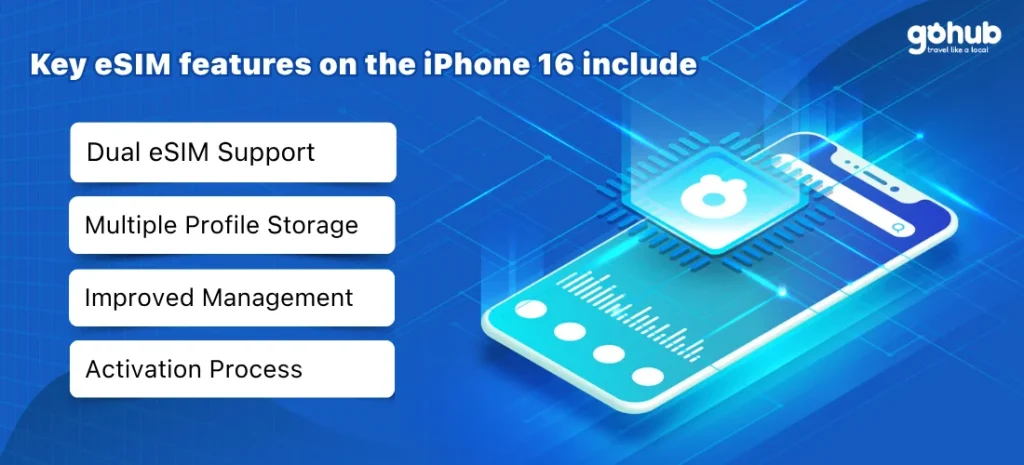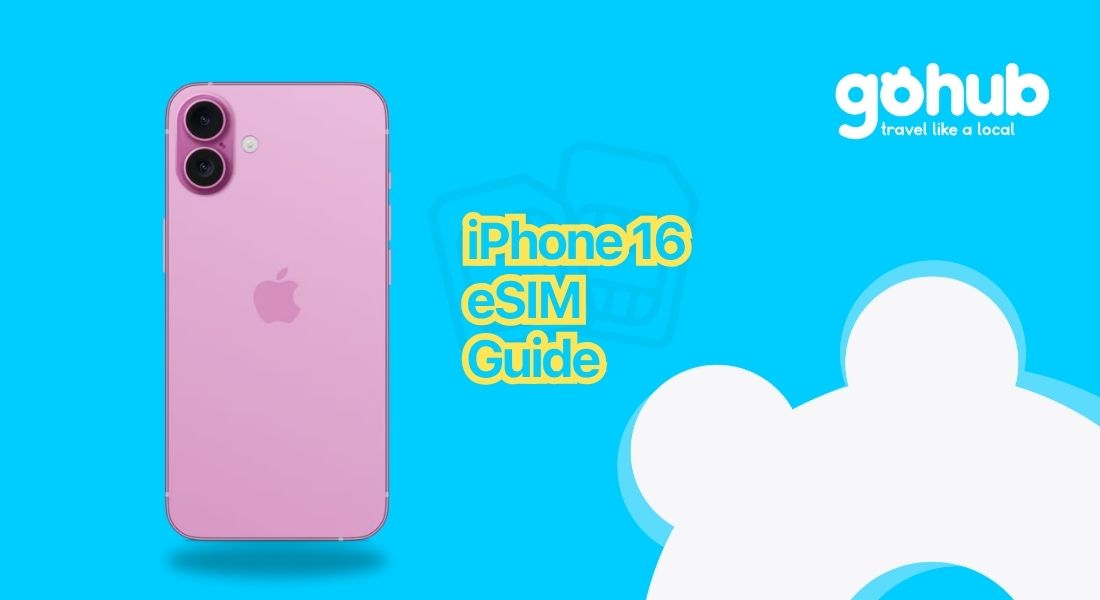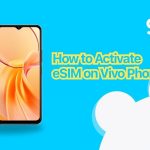If you’ve recently upgraded or are eyeing the new iPhone 16, particularly in the US, you might notice something missing – that familiar physical SIM card tray. This isn’t an oversight; it’s Apple doubling down on the future of mobile connectivity: eSIM technology. For international travelers, digital nomads, and anyone navigating multiple networks, understanding eSIM is becoming essential.
This post will dive into the world of eSIM, exploring its origins, Apple’s pivotal role (especially with the iPhone 16), its benefits for globetrotters, the fascinating differences in global adoption, and practical considerations for staying connected on the go.
✈️ Traveling with an iPhone 16 eSIM? Gohub makes it seamless—with global data plans, instant setup, no roaming fees, and real human support anytime.
I. Understanding eSIM Technology: Your Digital Ticket to Connectivity

First off, what exactly is eSIM? It stands for Embedded SIM. Unlike traditional SIM cards that you physically insert and swap, an eSIM is a small chip that’s embedded directly into your device. Think of it as a digital version of your SIM card.
The key difference is that an eSIM allows you to activate your mobile plan digitally without needing a physical card. It’s programmable and can be reconfigured remotely. This means you can switch carriers and plans without ever needing to visit a store or wait for a new SIM card to arrive. It simplifies how you manage mobile services, which is especially useful when traveling or switching networks.
First time with eSIM? Here’s how to install eSIM on iPhone.
II. The Road to eSIM: Origins and Apple’s Crucial Role
While Apple has been instrumental in bringing eSIM to the mainstream, they didn’t invent the technology itself. The standard for eSIM was set by the GSMA (Global System for Mobile Communications Association), which finalized it in 2016. Mobile chip makers like Qualcomm and Intel developed the necessary hardware.
However, Apple played a significant role in popularizing eSIM. They started integrating eSIM into iPhones beginning with the iPhone XS in 2018, being one of the first major smartphone brands to do so. The “real game-changer” and a “real pivotal moment for the SIM card market” came with the iPhone 14 (released in 2022 in the US), where Apple removed the physical SIM card slot entirely in favor of an eSIM-only design for US models. Apple has been instrumental in pushing eSIM into the mainstream.
So, while GSMA invented the standard, Apple was the innovator in bringing it to the mass market, including its integration in the iPhone 16.
Using Android instead? Follow our Android eSIM install guide.
III. iPhone 16 eSIM-Only Model: Features, Dual SIM, and Storage
The iPhone 16 builds on Apple’s commitment to eSIM. In the US, the iPhone 16 continues the trend of being eSIM-only, completely removing the physical SIM card slot. This move is seen as a step towards a future without physical SIMs.

Key eSIM features on the iPhone 16 include:
- Dual eSIM Support: You can activate and have two eSIM profiles active at once. This is fantastic for travelers who want to keep their home number active while using a local data plan.
- Multiple Profile Storage: The iPhone 16 series can store 8 or more eSIM profiles, allowing you to keep profiles for various countries you visit frequently.
- Improved Management: Apple has made managing eSIM profiles, switching between carriers, and adding new plans easier directly within the phone’s settings.
- Activation Process: Activating a new eSIM often involves scanning a QR code or using the phone’s settings. There’s also a Quick Transfer feature for moving existing physical or eSIMs from old devices.
If activation fails, this guide helps fix common eSIM errors.
IV. The Benefits of eSIM on iPhone 16 for Travelers
The shift to eSIM isn’t just about removing a tray; it offers practical benefits, particularly for those on the move:
- Enhanced Convenience: Activate new plans digitally without needing a physical card. Switching carriers or plans while traveling is significantly easier.
- Space Efficiency: Removing the SIM tray frees up internal space, potentially allowing for components like larger batteries or improving water resistance. Every bit helps when your phone is your lifeline on the road.
- Increased Security: eSIMs are embedded, making them harder to steal or clone compared to physical SIMs. This adds peace of mind when your device is your primary tool for navigation, banking, and communication abroad. One user noted they prefer eSIM for security reasons, as a stolen phone can’t have its SIM quickly removed to prevent tracking.
- Environmental Impact: Fewer plastic SIM cards mean less waste, aligning with eco-conscious travel values.
V. eSIM Adoption: Navigating the Global Divide
Here’s where it gets a bit more complex, especially for international travelers. The eSIM-only design is primarily for US models of the iPhone 16. Models sold outside the US, including in regions like Europe, Canada, the UK, Australia, and Japan, typically retain a physical SIM slot alongside eSIM capability. China models are noted as having 2x physical SIM slots.

Why the difference?
- Uneven Global Adoption: eSIM usage is simply lower in many regions, including parts of Europe.
- Carrier Readiness: Many MVNOs and even some major carriers outside the US haven’t fully adopted or streamlined eSIM support yet. Some speculate carriers outside the US “just don’t want to” fully adopt it yet, perhaps due to needing to invest or perceived loss of control.
- Market Dynamics: Apple isn’t as dominant in Europe as it is in the US. Forcing an eSIM-only model globally might cause Apple to “haemorrhage customers” in regions where physical SIMs are still needed or preferred due to carrier limitations. The fact that Apple does include a physical SIM slot outside the US suggests physical SIMs aren’t going away everywhere anytime soon.
Already have eSIM? Learn how to switch between different eSIM plans.
VI. eSIM and Travel: Freedom or Friction?
For travelers, eSIM offers significant potential convenience. You can activate local or regional data plans digitally before or upon arrival, potentially avoiding expensive international roaming fees. Providers like Chillax SIM, RedteaGO, and Nomad offer affordable international eSIM data plans. RedteaGO even claims to be an “Apple’s official eSIM partner”. Using these allows you to buy plans easily before you land and have signal instantly, without hunting for a physical SIM card at the airport. Nomad highlights using their service with iPhone 16 for seamless connectivity in over 180 countries.
However, the transition isn’t without potential friction, especially for travelers:
- The “Artificial Premium” Debate: Some users feel that international eSIM data plans carry an “artificial premium”. They argue that since eSIMs mean less work and lower costs for carriers (no physical card production or delivery), the plans should be cheaper than local physical SIMs, not more expensive. Local physical SIMs can often still offer better value.
- Data-Only Limitations: Many travel eSIMs are data-only. This is a crucial caveat, as a physical SIM might still be needed for SMS authentication required by banks or financial institutions, particularly in some countries in Asia. If your bank requires sending an SMS to your local number for verification, a data-only eSIM won’t suffice.
- Country Dependence: The availability and functionality of eSIM, even for travel, can vary significantly by country and carrier.
✈️ GOHUB’s eSIMs are built for this exact scenario: Buy before you fly, land with instant data. No roaming surprises, no SIM card queues.
VII. Potential Downsides and Real-World Challenges
Beyond travel specifics, users have pointed out other challenges with the move to eSIM:
- Transfer Difficulties: Transferring an eSIM to a new device can be challenging if your carrier doesn’t support a self-service transfer option. Some users have reported needing to contact or visit the carrier to complete a transfer.
- Device Failure: If your phone breaks, you cannot quickly swap an embedded eSIM into another device like you can with a physical SIM. This could leave you without service until you get a replacement device and can activate your plan on it.
- Carrier Pressure: Some users worry that carriers might try to force them off beneficial older plans when switching to eSIM, as the carrier might prefer users move to newer, potentially more expensive plans.
- Connectivity Issues: A user reported that their eSIM would sometimes lose connectivity periodically for a few minutes.
These points highlight that while the technology offers great convenience, the real-world experience can still present hurdles depending on your carrier and location.
VIII. Beyond the iPhone 16: The Future of eSIM
The iPhone 16 is part of a larger industry trend. eSIM technology is appearing in other devices like tablets and smartwatches, and other major phone manufacturers like Samsung (Galaxy, Z Fold, and Z Flip ranges) and Google Pixel are also integrating eSIM into their devices.
The adoption of eSIM is expected to continue growing rapidly across the smartphone industry. With increasing carrier support worldwide, the convenience and flexibility of eSIM will continue to improve. Although physical SIMs are still necessary in many parts of the world today, eSIM is undeniably the direction mobile connectivity is heading.
Want to keep your SIM too? Here’s how to use eSIM and physical SIM together.
IX. Conclusion
🧭 Whether you’re already using an iPhone 16 or planning to switch, GOHUB has curated eSIM plans that make global travel smoother. Check compatibility, buy online, and stay connected across 100+ countries—all from your phone.
While the question of “who invented esim in iphone 16” clarifies that GSMA set the standard and Apple popularized it, the bigger story for travelers is how this technology impacts their journey. The iPhone 16’s continued adoption of eSIM (especially in the US) marks a significant step towards a digital-first mobile experience.
The technology offers clear benefits like enhanced convenience, space savings, improved security, and environmental friendliness. For travelers, the ease of activating plans digitally and avoiding roaming fees is a major plus.
However, it’s crucial for travelers to be aware of the nuances – the global divide in adoption means physical SIMs are still common and necessary outside the US. Issues like potential “artificial premiums” on international plans, the data-only nature of some travel eSIMs, and challenges with transfers or device failure are real factors to consider.
Ultimately, eSIM is the future of mobile connectivity. With increasing adoption across devices and carriers, it promises a more seamless and flexible experience for users worldwide, making the iPhone 16 a powerful tool for the modern traveler navigating our increasingly connected globe. Just remember to pack your pragmatism alongside your passport and digital SIMs!
Not on Apple? See how to activate eSIM on Vivo.








